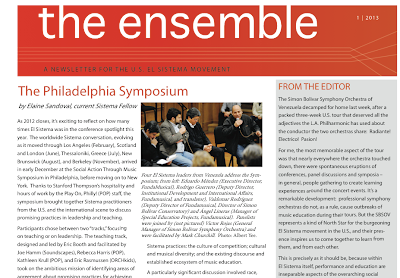8/18/2012
Today marks 3 months since the Sistema Fellowship ended, and
2 months since I started my position as Director of Education at Orchestra of
St. Luke’s. Before the year takes over and we become absorbed in planning and
running programs, I want to take some time to honor the process. It is such a
sweet time, to indulge in planning, to ask the hard questions about why we do
what we do, and what our vision is that will guide our future decisions. I
think it may be interesting to look back one day on how we arrived at our
decisions.
As an aside, today, the ten 2012-2012 Sistema Fellows
organized a conference call to catch up, and I realized how valuable it is both
to share ideas with brilliant people with similar passions, and to stay
connected to and inspired by their great work.
So, here’s a play-by-play of the highlights of the last two months of Education
directorship at the Orchestra of St. Luke’s.
June
Introduction to the
orchestra
During my second week, I sit in on a rehearsal with Gil Shaham and the orchestra,
conducted by Roberto Abbado. They sound gorgeous, and I’m overwhelmingly happy
to be surrounded by an orchestra again. This is going to be a beautiful
relationship. (The first time I met Gil Shaham was when he played with the
Berlin Philharmonic when I moved to Berlin in 2003.)
Team-building meeting
with the education team.
I wanted to get to know the team I’d be working with, to
spend some time learning from them why they do what they do and what they believe has been
successful in their past experiences with OSL. I realized that
asking these questions may seem a bit contrived, but I genuinely believe that our learning about each others' motivations and perceptions of success will help us develop our future meetings to be as productive and open as
possible. We started with these questions:
What inspires your
work? Kids making instruments; creating
opportunities for students to participate in music; discovering the work/play
and aesthetic experience that kids are having; creating and becoming part of a
culture of music; continuing to see how music can give a child or another
person a broader world perspective through music.
How do you define
success of the education department? Students articulating musical concepts
that they weren’t able to articulate at the beginning of the year; students
performing together; students and teachers walking away from concerts with a
deeper understanding of and connection to music; a re-defined vision of the
department and program plans that fit within that vision.
What would be your
personal inquiry question for our work this year?
How can an orchestra connect with its community?
What are the best ways of inviting people to an orchestra’s
activities?
How do we connect with our audiences?
How do we define the OSL community?
What is our role in arts education?
What are the differences between arts education organizations,
performance organizations, and educational systems?
I'm looking forward to looking back on these questions at
the end of the year (May 2013) and seeing how we answer them.
Getting to know the
community—what is the need in this community?
As I learned from
David France, you can never know a
community unless you get out and talk to people. So, we did. And what we
learned was so much more than we could have learned looking online in an
office. Mark (as in Mark Caruso, Assistant Director of Education at OSL) and I created a list of questions to ask people and a list of
people to ask. We went out talking to local business owners, local residents to
let them know about The DiMenna Center (DMC) and OSL, and to ask what community
organizations they know about in the neighborhood. We learned a great deal
about the neighborhood, and also realized that this was just the beginning of
our investigation. In short, two big themes kept coming up:
1. People felt that there aren't many activities that draw community members together, and that they'd like there to be more events that do this. The neighborhood is becoming rapidly affluent, but there are still many people living in shelters and transitional homes, and little is being done to make all residents feel a sense of neighborhood connection.
2. The schools reported that they felt there could be far more family involvement in the school activities.
Both of these things will help us to make a case for creating a youth orchestra with inter-generational opportunities.




